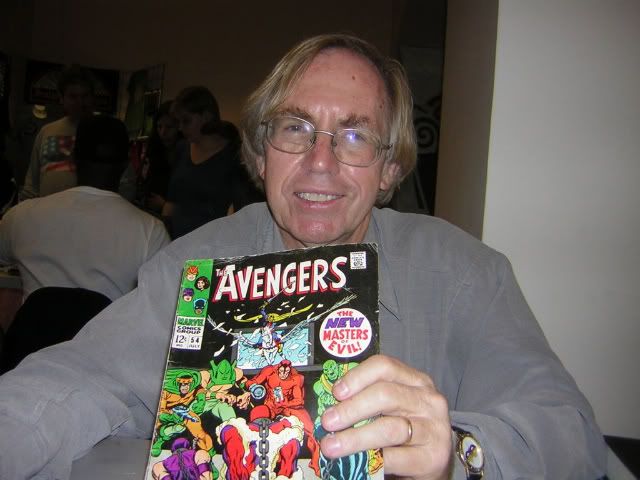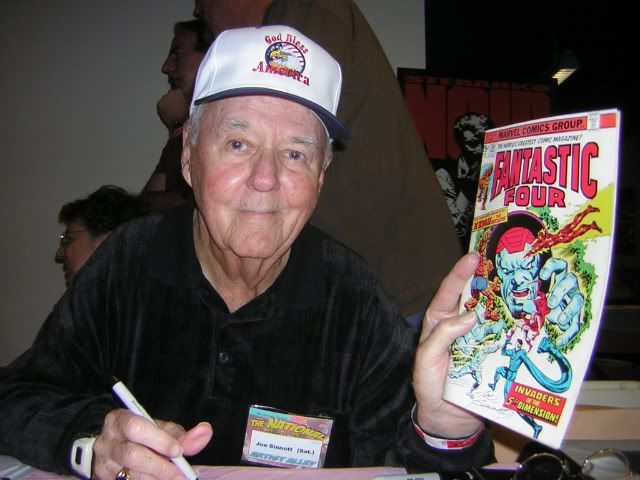The Jack Kirby Tribute Panel was composed of Mark Evanier, Roy Thomas, Joe Sinnott, and Stan Goldberg (Marvel Colorist). Again Dick Ayers was invited, but did not attend.
Evanier was there before anyone else and he spoke casually to the audience before the panel began. He told a story about calling up his and Kirby’s friend Sergio Aragonés and apologizing that no picture of him was included in “Kirby: King of Comics.” Apparently there was supposed to be, but somehow it didn’t make it. Anyway Sergio bet Evanier $25 thousand dollars that there was a picture of him in the book and apparently in one picture there’s a tiny picture of Sergio hanging on the wall in the background.
Evanier also talked about why he does these tribute panels for Kirby. He said that even though Kirby has been gone for 14 years he is still so popular that people come up to him and say, “Can I shake your hand because you shook Jack’s?” And he says that when you get an audience together for a Jack Kirby tribute, he knows that it’s a group of the smartest and coolest people at the convention.

When everyone else got there Evanier started off the panel by asking Roy Thomas (Pictured above) if he ever saw Stan Lee jump on his desk and pose in heroic poses for Kirby?
Thomas said that must have been before his time, but that he was present for the infamous Herald Tribune argument, which he called “the nails in the coffin of their relationship”
Thomas also said that he remembers Stan Lee calling him into his office and saying, “Look at this crazy character Kirby put in this Galactus story,” the character was of course the Silver Surfer.
Thomas went on the record as saying his favorite artists are Gene Colan, John Buscema and Jack Kirby.
Thomas also said that Stan Lee was a great teacher, but that he didn’t know why he had clicked with Lee and ended up becoming a sort of heir to the throne at Marvel that it just happened that way. Thomas also said that he didn’t think Kirby was interested in teaching other artists because he didn’t want to teach them to be Jack Kirby; he wanted them to find their own way.
Evanier explained that Jack Kirby didn’t think like most people, “He had a mind that instead of going from A to B to C would go from A to Z to R to S to B.” He said that Stan and Jack would talk about the Fantastic Four and that Jack would go home and draw an issue of Thor. He said that when you asked either of them they would both inevitably say that they had each done 90% of the work on any given issue.

It was fascinating to hear Joe Sinnott (pictured above) talking about his work because Evanier asked him if he was ever late turning in issues. (This is especially relevant today when inkers are being blamed for the current FF comics being several months late.) Sinnott replied that he was never late with an issue and that one time he had to work on Christmas day in order to not be late on a Steranko Captain America issue. (I wish Marvel still had that work ethic today!)
Sinnott said that he was always in awe of Kirby’s work and that he couldn’t wait to see the new pages of the FF each month and that his excitement never waned. He also recalls seeing Fantastic Four # 5 and thinking to himself “Gee, there’s something special here.” Sinnott dropped the bombshell revelation that he never read an issue of the Fantastic Four, “Jack told everything with pictures,” he said.
Sinnott mentioned again that Kirby and him never talked while they were working on the Fantastic Four
Sinnott said that at first he’d want to correct certain details in Kirby’s work like strange looking ears, or muscles that didn’t exist in real life, but that he realized that if he did that it just wasn’t Kirby anymore. (I couldn’t help but think of Cap’s feet on the cover of Avenger 4)
Sinnott said that when he worked with a brush inking that he could do 3 pages a day. Sinnott explained that you always ink from the bottom of the page up so that you don’t smear any ink. He said that he’d start with page 2 because he wanted to get into the story and that he’d do the splash page last. He also said that he thought Kirby’s splash pages were better than his covers.
Evanier talked about how Kirby liked doing covers least of all because he couldn’t do them before he drew the story because he wasn’t sure what it was about yet and he couldn’t draw it in the middle when he’d figured out what the story was about because it broke up his concentration and he didn’t like to do the cover when he was done with the story because he wanted to move on to the next thing. He also said that if Kirby worked on something in the morning he might not even remember it in the afternoon. He said that Kirby was actually happy when other artists did the covers for issues he penciled.
Evanier also explained that the way Kirby’s mind worked he always saw the completed panel in his head before he drew it so he never used his eraser to change the way an arm was posed or something, he only used an eraser to change a panel in it’s entirety. He said that this was a problem at DC comics because they started asking for rough cover drafts for approval first. Evanier said Kirby would draw the actually cover first and then do the rough cover second.
“This is the man who decided to make the Hulk green.” Evanier said when he introduced Stan Goldberg, longtime Marvel colorist.
Goldberg said that he though Kirby’s comic about growing up in New York featured in one of Evanier’s books was breathtaking and better than any history book.
Goldberg said that his friend even after all these years still don’t understand what he did, they’ll ask him, “Are you still drawing Joke books?”
When asked about the Hulk’s coloring changing to green after the first issue he said that colors like gray or brown just aren’t dynamic for the lead character in a comic. He said, “That’s the color of most of the backgrounds.” When asked if there were similar reasons for the changes in Ironman’s look he quipped, “Have you ever seen a yellow piece of iron?” Goldberg said that when he was working he could color two books in one day. He also said that part of the reason why there are coloring errors from time to time is that they only ever received proofs of the covers before printing not the interior pages.
Evanier talked about how Kirby in the 70s was having trouble with the “Marvel method” because he wanted to write and draw. When asked about Kirby’s style changing over the years Evanier said that Kirby thought his style was always the same, but he admitted that Kirby started to have eye problems in the 70’s that interfered with his work.
The panel also talked about the change from 12” by 18” size page flats to 10” by 15” so that the printers could do 4 pages at once instead of two and save money. Evanier said that this change, which occurred in 1968, could best be seen in ASM Annual 5 in which the first half used the old size and the second half the new size.
“When he went to the small pages,” said Sinnott, “It ruined some of his style. I felt like his work was never the same.”
Someone in the audience asked if Kirby ever said anything about Darth Vader being so similar to both Doctor Doom and Darkseid. Evanier said that he remembers Kiby felt like “I found gold and someone else exploited it.” However, he said that Kirby wasn’t angry and that he liked the movie. “It’s not the artist that really gets upset when something like that happens it’s the artist’s wives.”
No comments:
Post a Comment